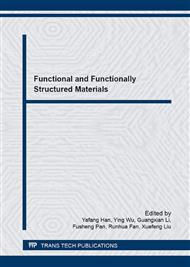[1]
B.X. Liu, L.J. Huang, L. Geng, B. Wang, C. Liu, W.C. Zhang. Fabrication and superior ductility of laminated Ti-TiBw/Ti composites by diffusion welding. J. Alloys Compd. 602 (2014) 187-192.
DOI: 10.1016/j.jallcom.2014.02.140
Google Scholar
[2]
D.J. Smith, Y.Q. Zuo, P.Q. Partidge, A. Wisbey. Bend stiffness and strength of laminates composed of titanium alloy and titanium metal matrix composite. Mat. Sci. Techno. 13 (1997) 35-40.
DOI: 10.1179/mst.1997.13.1.35
Google Scholar
[3]
J. Ma, G.E.B. Tan, Z.M. He. Fabrication and Characterization of Ti-TiB2 Functionally Graded Material System. Metall. Mater. Trans. A. 33 (2002) 681-685.
DOI: 10.1007/s11661-002-0130-5
Google Scholar
[4]
K.B. Panda, K.S. Chandran. Titanium-titanium boride (Ti-TiB) functionally graded materials through reaction sintering: synthesis, microstructure and properties. Metall. Mater. Trans. A. 34 (2003) 1993-(2003).
DOI: 10.1007/s11661-003-0164-3
Google Scholar
[5]
M. Lugovy, V. Slyunyayev, N. Orlovskaya, G. Blugan, J. Kuebler, M. Lewis. Apparent fracture toughness of Si3N4-based laminates with residual compressive or tensile stresses in surface layers. Acta Materialia. 53 (2005) 289-296.
DOI: 10.1016/j.actamat.2004.09.022
Google Scholar
[6]
K.L. Hwu, B. Derby. Fracture of metal/ceramic laminates-I. transition from single to multiple cracking. Acta Materialia. 47 (1999) 529-543.
DOI: 10.1016/s1359-6454(98)00357-7
Google Scholar
[7]
T.Z. Li, F. Grignon, D.J. Benson, K.S. Vecchio, E.A. Olevsky, F.C. Jiang, M.A. Meyers. Modeling the elastic properties and damage evolution in Ti-Al3Ti metal-intermetallic laminate (MIL) composites. Mater. Sci. Eng. A. 374 (2004) 10-26.
DOI: 10.1016/j.msea.2003.09.074
Google Scholar
[8]
A. Rohatgi, D.J. Harach, K.S. Vecchio, K.P. Harvey. Resistance-curve and fracture behavior of Ti-Al3Ti metallic-intermetallic laminate (MIL) composites. Acta Materialia. 51 (2003) 2933-2957.
DOI: 10.1016/s1359-6454(03)00108-3
Google Scholar
[9]
C.M. Cepeda-Jimenez, F. Carreno, O.A. Ruano, A.A. Sarkeeva, A.A. Kruglov, R.Y. Lutfullin. Influence of interfacial defects on the impact toughness of solid state diffusion bonded Ti-6Al-4V alloy based multilayer composites. Mat. Sci. Eng. A. 563 (2013).
DOI: 10.1016/j.msea.2012.11.052
Google Scholar
[10]
B.S. Li, J.L. Shang, J.J. Guo, H.Z. Fu. In situ observation of fracture behavior of in situ TiBw/Ti composites. Mat. Sci. Eng. A. 383 (2004) 316-322.
DOI: 10.1016/j.msea.2004.04.071
Google Scholar
[11]
B. Lawn. Fracture of brittle solids-second edition. Cambridge solid state science series. Cambridge university press. (1993).
Google Scholar
[12]
B.X. Liu, L.J. Huang, L. Geng, B. Kaveendran, B. Wang, X.Q. Song, X.P. Cui. Gradient grain distribution and enhanced properties of novel laminated Ti-TiBw/Ti composites by reaction hot-pressing. Mat. Sci. Eng. A. 595 (2014) 257-265.
DOI: 10.1016/j.msea.2013.12.013
Google Scholar


